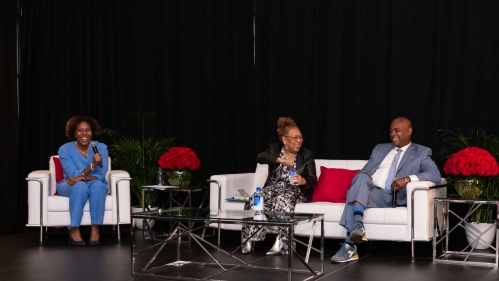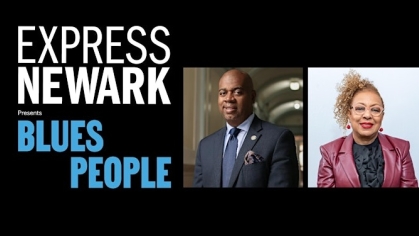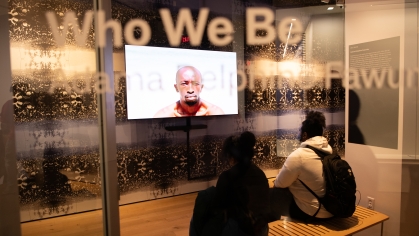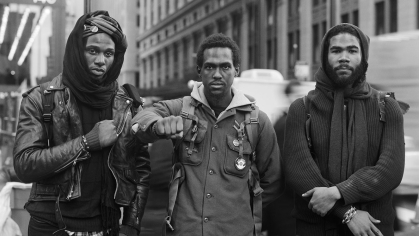Newark Mayor Ras Baraka and Sister, Art Historian Kellie Jones, Share Childhood Memories and Thoughts on Art and Politics at Express Newark Event

Newark Mayor Ras Baraka and his sister, art historian Kellie Jones, shared stories of a childhood shaped by their father, legendary Newark writer and activist Amiri Baraka, and reflected on the legacy of his seminal 1963 book “Blues People” at Express Newark on Wednesday.
The siblings also explored the relationship between art and politics at the event, a conversation moderated by Express Newark Executive Director and Pulitzer Prize-winner Salamishah Tillet, a Rutgers-Newark professor of Africana Studies and Creative Writing. Titled “Children of the Cosmos,’’ the talk marked the first time Baraka and Jones appeared together at a public forum.
Express Newark has been celebrating “Blues People: Negro Music in White America”-- a groundbreaking work written when Baraka went by the name LeRoi Jones– with an exhibition of art created in conversation with the book and a year-long series of events. “Blues People” uses the evolution of Black music in the U.S. to trace how enslaved Africans became African-American.
Before the conversation began, Tillet explained why “Blues People” is relevant today. She compared contemporary violence overseas–including a para-militarized Port au Prince, death tolls in West Darfur and Gaza, and domestic attacks against democracy and Diversity and Inclusion efforts–with the political landscape of the early 1960s.
“That book, because it’s from another era of global war and civil rights conflict…and because it was trying to make sense of its own era, might teach us something about ourselves,’’ she said. “It might be how to survive, how to listen intently. It might tell us how to be a people, forged in conflict but determined to see the beauty, commit to love, and forge ourselves, with the remnants of the past and the resources of the present, into something new. That newness, if we try hard enough, might get us closer to justice.’’
Tillet introduced the mayor, now a gubernatorial candidate, by listing his credentials as a published poet and repeating a frequent Baraka boast: that he is the city’s first mayor within the past 50 years to be born in Newark.
Jones, the eldest daughter of Baraka and his first wife, the writer Hettie Jones, is the Chair of the Department African American and African Diaspora Studies and a professor of Modern Art in the Department of Art History and Archaeology at Columbia University. She is also a curator and a 2016 recipient of the MacArthur Genius Grant, who has published books on art history, with a focus on African American artists.
Tillet opened the talk by asking Baraka and Jones when they first read “Blues People” and how it affected them.
Baraka–who said he never read any of his father’s books until he moved out of the house– read “Blues People’’ in college (“it wasn’t assigned,’’ he said). He was struck by how much it applied to the hip-hop music he was listening to at the time: artists such as Public Enemy, KRS One and Erick B.& Rakim.
“To me it made perfect sense,’’ he said. “The music was, as Public Enemy said, our CNN. You can determine what period of history we’re in by the music that was being made.’’
What stayed with Jones is how deeply the book intertwines music with the history of its creators.
“He wrote about music as a part of life and art as a part of life. In fact, you don’t have life if you don’t have art. You can’t work at a job– can’t slave, as some people would say– and just do that. You have to have something that is another part of your life. And art is another part of life,’’ she said.
Jones added that during her research in graduate school, she sought some of the same sources cited in the book, including anthropologists such as Newbell Niles Puckett, author of “Folk Beliefs of the Southern Negro.’’
Jones and Baraka agreed that much of what American students learn about art has centered on European works, and that Black people’s contributions–and how they have shaped American art and culture–have been overlooked.
Baraka mentioned Black artists whose work is quintessentially American, including the writings of enslaved 18th-century poet Phyllis Wheatley, but not given its due.
“Black writers and Black musicians are truly, authentically American. And maybe it scares people to know that,’’ said Baraka.
The siblings recalled what it was like growing up in the Baraka family, surrounded by visiting writers and musicians, including jazz artist Archie Shepp, the father of photographer Accra Shepp, whose work is showcased in the “Blues People” exhibition.
“People always think your father and mother sit you down and give you lectures and you take notes. That is the furthest thing from what actually happened,’’ he said. “Everyone comes to the house all the time, from kids to adults to neighbors. They’re playing basketball or hanging on the porch or there’s an activist event that goes on until the wee hours. There’s poetry, jazz, all kinds of people– from Miguel Pinero to dub poets, to folks from all over the world–getting up to give diatribes in the living room,’’ Baraka remembered.
Jones described a house filled with avant garde jazz that became the soundtrack to her childhood. “Ornette Coleman and Archie Shepp are comfort music for me,’’ she joked.”It calms me down.’’’
Growing up among so many Black and brown artists, Jones was disturbed to discover that her college art history classes included few lessons on living artists, particularly artists of color.
“You wouldn’t even know artists were alive because the only people they taught us about were dead. And most of them were European, or they’re talking about ancient Egyptians and Mayans,’’ she said. “It’s like there’s no other people of color who ever became artists. That’s not true.’’
Later in the conversation, the mayor shared stories about his mother, Amina, a poet, activist and feminist, who told him about the crucial but often difficult role that Black women played in the era’s political movements.
“The cultural nationalist space was very male dominated,’’ he said.
What was true for Black women then is often true today, he said. “You have to uplift Black men and save yourself from them at the same time.’’
After Jones’ and Baraka’s sister, Shani Baraka, was killed by her estranged husband in 2003, the mayor wrote the poetry collection “Black Girls Learn Love Hard.’’ Amiri Baraka’s sister, Kimako, was also murdered by a man in 1984.
Prompted by Tillet, Jones and Baraka spoke of public art as a way to “speak truth to power. “
Baraka replied, “We have murals and monuments around the city because we want people to see art, to live it and experience it. To walk down the street and have conversations about it. If the Harriet Tubman monument can make people talk about something different than they would have before they approached it, that’s what we want them to do. And hopefully that conversation leads them to thinking–and hopefully changes their mind about a few things and gets them to act on stuff that they might not have acted upon before.”
Jones cited the words of artist David Hammons. “Just put art in the way, so that someone trips over it, runs into it,’’ she said. “It’s like air. It changes your environment, changes your mind. Hopefully it has some catalytic function in that way.’’
Tillet asked Baraka to comment on his father’s words, “The purpose of politics is to protect truth and beauty.’’
Baraka answered, “I think that the work we do is art. Every day, you try to change people’s condition, and to me, that’s the beauty of it. When you see a woman who lived in the projects all her life, generationally, and now she has a key to her own home with a backyard, that’s the beauty of it; or a kid who was incarcerated and came home to nothing, now is in college pursuing a degree; or a building that was abandoned and you turned into artist housing or a co-op space; that’s you doing art.”
Before Baraka and Jones took the stage, Express Newark resident poet Jasmine Mans, a native Newarker who has built a national following, read her poem “Blues People 2024 (After Amiri Baraka)” and another titled “The 39th Street Bus Makes Stops in the South Ward.” That piece was commissioned by the mayor and includes descriptions of Newark streets, family gatherings, and neighborhood landmarks, like King’s Restaurant.
“I come from a city that always had enough home to come home to,’’ she recited.
The “Blues People” talk, exhibition, and other programming was funded by the Andy Warhol Foundation for the Visual Arts and the Harbourview Foundation.
“In the short time since its inception, Express Newark has raised the visibility of the city’s legacy of art and activism and provided essential space and resources for contemporary artists to collaborate, experiment, exhibit, and educate others,’’ said Rachel Bers, program director for the Andy Warhol Foundation. “Its focus on visual culture and justice is an important part of the larger national conversation about contemporary art and social change and the foundation is very pleased to be able to contribute to its flourishing.”


